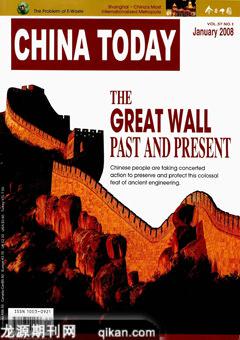Sci-tech Info
Fuel Cell Vehicles
Chinas Ministry of Science and Technology (MST) and the United Nations Development Program have launched a pilot project to commercialize fuel cell vehicles. Under the project, Shanghai will use buses powered by clean energy fuel cells beginning in 2009. To achieve this goal, the city is working on relevant infrastructure, and a new hydrogen fuel station is about to go into operation. The project focuses on improving fuel cells in order to make the technology commercially viable for urban transportation. The MST will actively promote the project as a strategy to help reduce green house gas emissions and air pollution.
Digital Nose Sniffs Out Bad Food
Theres now a digital nose that can tell whether food is fresh or not. The nose contains 18 sensor organs, just like the olfactory receptor cells of the human nose, that respond to gases produced by rotting food. After making a comparison with normal smells and carrying out a complex analysis, the nose concludes within about an hour whether or not food has gone bad. The machine has been developed by Shanghai Fisheries University and can be used to test meat, eggs, milk and fish.
Satellite Technology Serving the People
Chinas first moon orbiter, Change I, successfully entered the moons obit in late 2007, and will send back data on the celestial body for 12 months. Change Is successful deployment marks a big step forward in Chinas space exploration, following the nations initial satellite launches in the 1970s and manned space flights in 2003 and 2005.
The development of satellite technology has greatly assisted ordinary Chinese people, especially in the area of disaster management. China is a country that experiences frequent natural disasters, which cost up to RMB 200 billion annually. Satellites help to predict typhoons, torrential rains and mudflows, and estimate their strength and duration. These forecasts save both lives and money. Satellites also provide other services related to telecommunications, data transmission, TV broadcasts, car navigational systems and remote medical treatment.
Beijings “Green” Watercube
The soon to be unveiled Olympic venue the Watercube, aka the National Aquatics Center, is capable of cleaning itself and acts as a giant greenhouse, trapping natural sunlight to illuminate and heat its interior. More than 3,000 translucent cushions cover the building, allowing soft rays of sunlight to brighten most areas, reducing power consumption by 30 percent. Advanced technologies and innovative designs are widely employed in the construction of all Olympic venues to decrease resource consumption. In the Olympic Village, all hot water is provided through solar energy, which also provides 90 percent of the power for street and lawn lighting. In addition, water recycling systems have been installed at every Olympic site.
Car Exhaust Alarm
A single-chip micro-controller (SCM) may soon be letting drivers know if their car exhaust surpasses air pollution standards. The microcomputer, invented by a high school student in Hunan, will cut off electricity and petrol automatically if drivers do not take measures to deal with excessive exhaust fumes within a set time. Youthful inventor Lu Jianfeng says he will further improve his gadget to make it suitable for the detection of waste gas, and hydraulic and water pipe pressure.
The Secret of DNA Modifying
Chinese and American scientists have discovered a self-modifying phenomenon in human DNA. Using technologies such as high performance liquid chromatography and gas chromatography, researchers from Shanghai Jiao Tong University and Massachusetts Institute of Technology uncovered the chemical processes involved in this phenomenon by studying germ DNA giant molecules. DNA comprises carbon, hydrogen, oxygen, nitrogen and phosphorus, and is central to all genetic phenomena in nature. In the last few decades, scientists have treated some illnesses by artificial DNA modifiers, but the discovery tells them DNA molecules can modify themselves. The researchers predict it is possible that the modifying can protect DNA from attack by some nucleases, and even control gene expression.
Man-made Sun Expected
to Power China
A test version of a man-made “sun” has been constructed in China, using technology that may help to provide the countrys energy supply within 30 to 50 years. Developed by Wan Yuanxi, a researcher with the Institute of Plasma Physics at the Chinese Academy of Sciences, the instrument can control nuclear fusion between deuterium and tritium in a magnetic vessel. Compared to traditional fossil fuels and old-fashioned nuclear fission, nuclear fusion is cleaner and produces far more energy. Hydrogen fusion, for example, “powers” the sun, producing massive amounts of light and heat. The 30 milligrams of deuterium contained in every liter of water can produce energy equivalent to that produced by 300 liters of gasoline. The Earths seawater contains around 45 trillion tons of deuterium, a supply that could last billions of years. China is taking part in an international cooperation project to develop the technology, along with the U.S., E.U., R.O.K., Japan and India.
Lenovo Think Again
Chinese computer giant Lenovo has developed its first two “Think” computers since it bought IBM PC in 2004. Think Station S10 and Think Station D10 both use Intel processors and are aimed at professionals working in oil and natural gas exploration, computer-aided design and digital content creation. The new members of the “Think” lineup are planned to be launched in January 2008. The S10 is priced at US $1,199 and the D10 at $1,739. According to the takeover agreement, the Chinese company can use the IBM brand for five years. But Lenovo CEO William Amelio said the company would cease using IBM two years earlier than originally planned.

